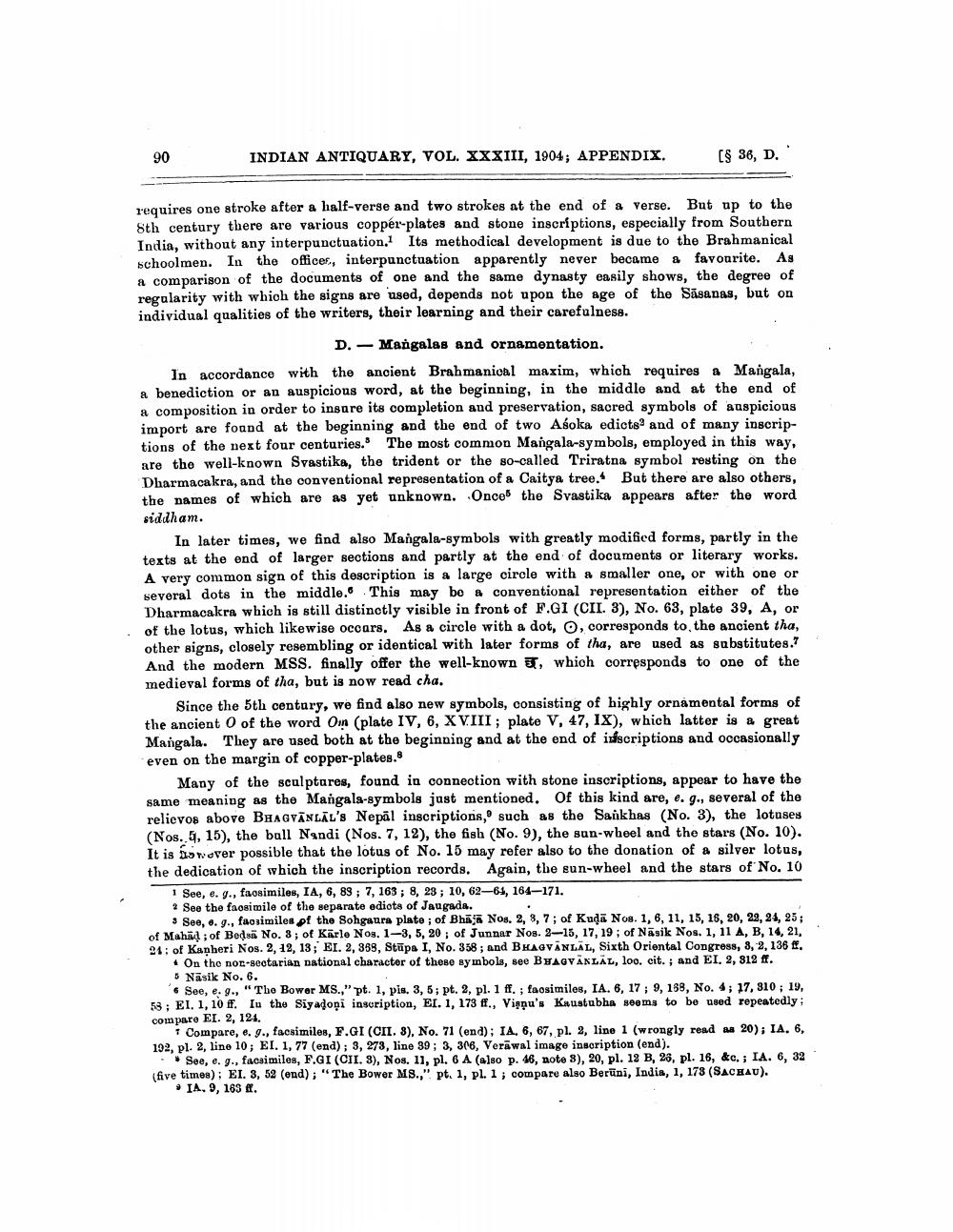________________
90
INDIAN ANTIQUARY, VOL. XXXIII, 1904; APPENDIX.
[§ 36, D.
requires one stroke after a half-verse and two strokes at the end of a verse. But up to the 8th century there are various copper-plates and stone inscriptions, especially from Southern India, without any interpunctuation. Its methodical development is due to the Brahmanical schoolmen. In the offices, interpunctuation apparently never became a favourite. As a comparison of the documents of one and the same dynasty easily shows, the degree of regularity with which the signs are used, depends not upon the age of the Sasanas, but on individual qualities of the writers, their learning and their carefulness.
D. Mangalas and ornamentation.
In accordance with the ancient Brahmanical maxim, which requires a Mangala, a benediction or an auspicious word, at the beginning, in the middle and at the end of a composition in order to insure its completion and preservation, sacred symbols of auspicious. import are found at the beginning and the end of two Aśoka edicts and of many inscriptions of the next four centuries. The most common Mangala-symbols, employed in this way, are the well-known Svastika, the trident or the so-called Triratna symbol resting on the Dharmacakra, and the conventional representation of a Caitya tree. But there are also others, the names of which are as yet unknown. Once the Svastika appears after the word siddham.
In later times, we find also Mangala-symbols with greatly modified forms, partly in the texts at the end of larger sections and partly at the end of documents or literary works. A very common sign of this description is a large circle with a smaller one, or with one or several dots in the middle. This may be a conventional representation either of the Dharmacakra which is still distinctly visible in front of F.GI (CII. 3), No. 63, plate 39, A, or of the lotus, which likewise occars. As a circle with a dot, O, corresponds to, the ancient tha, other signs, closely resembling or identical with later forms of tha, are used as substitutes.7 And the modern MSS. finally offer the well-known, which corresponds to one of the medieval forms of tha, but is now read cha.
Since the 5th century, we find also new symbols, consisting of highly ornamental forms of the ancient O of the word Om (plate IV, 6, XVIII; plate V, 47, IX), which latter is a great Mangala. They are used both at the beginning and at the end of inscriptions and occasionally even on the margin of copper-plates.8
Many of the sculptures, found in connection with stone inscriptions, appear to have the same meaning as the Mangala-symbols just mentioned. Of this kind are, e. g., several of the relievos above BHAGVANLAL'S Nepal inscriptions, such as the Sankhas (No. 3), the lotuses (Nos. 5, 15), the ball Nandi (Nos. 7, 12), the fish (No. 9), the sun-wheel and the stars (No. 10). It is however possible that the lotus of No. 15 may refer also to the donation of a silver lotus, the dedication of which the inscription records. Again, the sun-wheel and the stars of No. 10
1 See, e. g., facsimiles, IA, 6, 83; 7, 163; 8, 23; 10, 62-61, 164-171.
2 See the faosimile of the separate edicts of Jaugada.
3 See, e. g., facsimiles of the Sohgaura plate; of Bhaja Nos. 2, 3, 7; of Kuda Nos. 1, 6, 11, 15, 16, 20, 22, 24, 25; of Mahad; of Bedsä No. 3; of Karle Nos. 1-3, 5, 20; of Junnar Nos. 2-15, 17, 19; of Nasik Nos. 1, 11 A, B, 14, 21, 24: of Kanheri Nos. 2, 12, 13; EI. 2, 388, Stupa I, No. 358; and BHAGVANLAL, Sixth Oriental Congress, 3, 2, 136 ff. On the non-sectarian national character of these symbols, see BHAGVANLAL, loo. cit.; and EI. 2, 312 ff. 5 Nasik No. 6.
See, e. g., "The Bower MS.," pt. 1, pis. 3, 5; pt. 2, pl. 1 ff.; faosimiles, IA. 6, 17; 9, 188, No. 4; 17, 310; 19, 53; EI. 1, 10 ff. In the Siyadoni inscription, EI. 1, 173 ff., Visnu's Kaustubha seems to be used repeatedly; compare EI. 2, 124.
Compare, e. g., facsimiles, F.GI (CII. 3), No. 71 (end); IA. 6, 67, pl. 2, line 1 (wrongly read as 20); IA. 6, 192, pl. 2, line 10; EI. 1, 77 (end); 3, 273, line 39; 3, 306, Verawal image inscription (end).
See, e. g., facsimiles, F.GI (CII. 3), Nos. 11, pl. 6 A (also p. 46, note 8), 20, pl. 12 B, 26, pl. 16, &c. ; IA. 6, 32 (five times); EI. 3, 52 (end); "The Bower MS.," pt. 1, pl. 1; compare also Beruni, India, 1, 173 (SACHAU).
• IA. 9, 163 ff.




